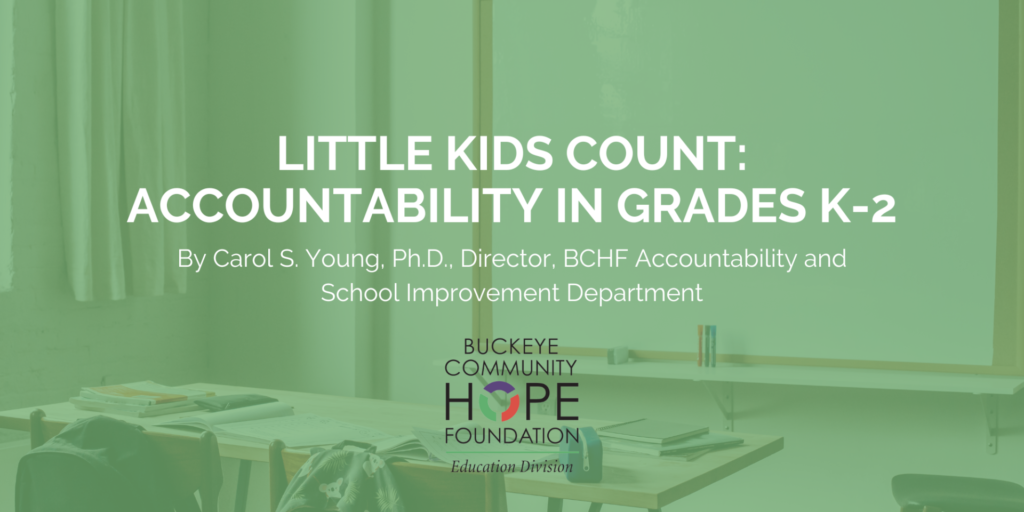By Carol S. Young, Ph.D., Director, BCHF Accountability and School Improvement Department
What are your school’s K-2 report card measures? Many of us would answer by saying that school accountability in Ohio does not start until grade three, when the first state tests occur. Ohio, in fact, does have some K-2 accountability measures, important ones. In addition to Ohio’s measures, though, all schools should measure critical K-2 outcomes annually. Achievement of foundation skills in early grades is the basis for future learning.
Ohio Accountability Measures
K-2 accountability on Ohio’s school report card is evident in two important components— Gap Closing and Early Literacy. Hidden in the gap closing detail on the school report card is the chronic absence improvement rate. This rate pertains to the percentage of students in given subgroups who are absent for more than 10% of scheduled instruction. All accountable students, including K-2 students enrolled in the school for one hundred hours or more, are in this calculation. To earn points for subgroups on this indicator, the chronic absence rate must meet the ESSA goal (18.3% or lower for 2023-24) or improve upon the school’s prior performance for the prior year by a school-based improvement standard, usually 1.1% or more (DEW, 2023). The chronic absence indicator sends a clear message about all K-12 students: It is important to have regular school attendance at all levels of schooling.
Calculation of Ohio’s Early Literacy Component on the Ohio School Report Card recently changed. The component is comprised of three calculations: proficiency in third grade reading, promotion to fourth grade, and improving K-3 literacy. Of these, the “improving K-3 literacy” measure evaluates reading improvement from kindergarten to grade 1, grade 1 to grade 2, and grade 2 to grade 3. Scores for grades K-2 come from the Ohio Diagnostic Assessment or alternate approved tests, such as NWEA or STAR. Each test has designated cut scores associated with off-track or on-track student reading achievement (DEW, 2023). The message is truly clear: schools need to provide high-quality core instruction and support needed to accelerate the learning of students who are not on track to read at grade level. Research supports the urgency of high-quality early reading instruction and intervention. What was your school’s overall “recovery” rate from off-track to on-track reading? This important data point is a key baseline indicator for school improvement.
School-based Accountability Measures
BCHF would advocate a full “report card” of K-2 outcomes at your school. Setting clear expectations is the basis for transparent communication among all stakeholders— educators, parents, and, most importantly, students themselves. For example, every kindergarten student should be able to write complete sentences. Every first-grade student should be able to write a well-formed paragraph. What percentage of your school’s students can demonstrate these skills? This percentage is important, part of the “report card” your school should analyze every school year. Percentages from one year become the baseline for improvement in subsequent school years. Action to close early gaps is an even more important response. If a student or group of students is unable to meet this measure, what kinds of re-teaching, intervention, high-dosage tutoring, or summer programming shall we, as a school, implement?
The Ohio Learning Standards are a roadmap to knowledge and skills all students must learn. To fulfill our responsibilities as educators, we must be accountable for all students’ learning, even those too young for most state metrics. Teacher-based grade level teams are the most appropriate group to establish, monitor, and report the accountability of grades K-2. We would encourage schools to task their teams with a full report card of the important outcomes for each early grade level. What percentage of students know math facts to 10? What percentage can blend sounds into one-syllable words? Reporting these specific skills and rates of attainment by your students builds transparency and accountability. Skills that are most problematic may indicate a lack of teaching attention, a mismatch with culture, or even an inadequacy in key textbooks or resources. Devise your own K-2 report cards and pinpoint your school’s next K-2 improvement steps.
The advantages of strong school accountability in early learning are clear. When students reach or exceed intended outcomes in K-2, we set a firm foundation for future learning. Students, parents, and school personnel benefit from decreased time in review and intervention. Clearly stated goals for each early grade level invite collaboration among parents, community organizations/agencies, and parents. What if local pre-K/daycare programs were aware of the important kindergarten outcomes at your school? More focused early learning may occur even before school entry.
At a critical point in my career, I worked with a group of first grade teachers to set early “report card” goals. The teachers agreed on an ambitious reading fluency goal of 120 words correct per minute for all first graders, a measure commonly associated with very fluent second-grade reading. Students read and recorded their fluency monthly. Once a student achieved the 120 wcpm goal, the teacher gave them a new chapter book! Reading achievement scores soared and remained strong.
What is a first grader supposed to be able to know and do? Just set a challenging goal and see! Little kids do count, and their achievement sets the tone for years to come.
–
Department of Education and Workforce (2023). The gap closing component technical document. Retrieved from Gap-Closing-Component-Technical-Documentation-2022-2023.pdf.aspx (ohio.gov).
Department of Education and Workforce (2023). The early literacy component. Retrieved from Early-Literacy-Technical-Documentation-2022-2023.pdf.aspx (ohio.gov).

